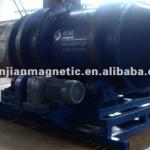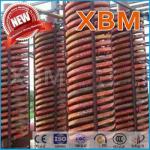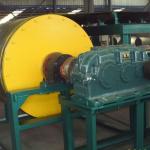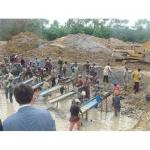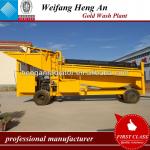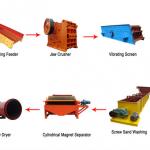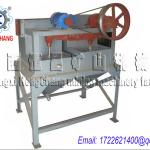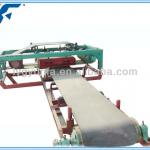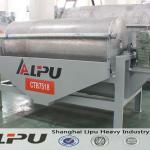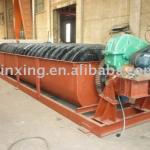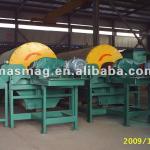Magnetic Separator for processing Red Mud
| Condition:New | Type:Magnetic Separator | Place of Origin:Hunan China (Mainland) | Brand Name:DLS |
| Model Number:DLS | Ring Diameter:500~3000 mm | Capacity (iron ore):0.05~250 t/h | Background field:-11000 GS |
| Ore-feeding size:-1.3 mm | Machine weight:2~175 tons |
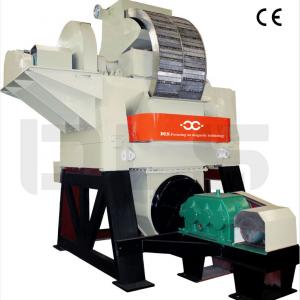
High Gradient Magnetic Separator DLS Series
l Product introduction
DLS Series high gradient magnetic separator is a new product developed independently by Dalishen. It combines the characteristics of international advanced high intensity magnetic separators, which is so far the high intensity magnetic separator of best performance and most advanced technology. This product utilizes vertical ring rotation, pulsating beneficiation and high frequency vibrator, and it has no magnetic medium jam problem in flat ring high intensity magnetic separator and flat ring high gradient magnetic separator.
It has the advantages of large beneficiation ratio, high security and convenient operation etc. This product realizes both high beneficiation ratio and high recycle ratio in separating weak magnetic minerals.
l Application field
1. Updating Ferrous Metals: Martite, Hematite, Siderite, Chromite, Ilmenite, Manganese, Etc.
2. Separating Non-Ferrous Metals: Wolframite and Quartz, Pyrrhotite and Cassiterite, Wolframite and Cassiterite, Limonite Purifying, Scheelite, Wolframite and Garnet, Etc.
3. Recovering Rare Earth: Tantalum and Niobium, Lepidomelane, Monazite, Etc.
4. Brightening Non Metals: Quartz, Feldspar And Kaolin for Ceramics, Sillimanite, Cassiterite, Andalusite, Kyanite for Refractory, and Separating Impurities From Hornblende, Mica, Tourmaline, Garnet, Etc,
l Technical features
1. Vertical Ring Rotation & Pulsating Beneficiation
2. High Frequency Vibration Mechanism
3. Wide Range of Feed Particle Size
4. Multi-Gradient Matrixes & Liquid Level Control System.
These technologies improve the grade of magnetic concentrate and recovery.
5. Frequency Conversion Step-less Adjustment for Rotary Speed & Vibrating Frequency.
6. No Stepper Phenomenon of Rotary Rings
l Technical data
| Model Part | DLS-50 | DLS-75 | DLS-100 | DLS-125 | DLS-150 | DLS-175 | DLS-200 | DLS-250 |
| Ring diameter (mm) | 500 | 750 | 1000 | 1250 | 1500 | 1750 | 2000 | 2500 |
| Particles size mm (-200 mesh) | -1.0 (30-100) | -1.0 (30-100) | -1.3 (30~100) | -1.3 (30~100) | -1.3 (30~100) | -1.3 (30~100) | -1.3 (30~100) | -1.3 (30~100) |
| Slurry density (%) | 10~40 | 10~40 | 10~40 | 10~40 | 10~40 | 10~40 | 10~40 | 10~40 |
| Slurry throughput (m3/h) | 0.5~1.0 | 1.0~2.0 | 12.5~20 | 20~50 | 50~100 | 75~150 | 100~200 | 180~450 |
| Handling capacity (t/h) | 0.05~0.25 | 0.1~0.5 | 4~7 | 10~18 | 20~30 | 30~50 | 50~80 | 80~150 |
| Rated back ground Field intensity (T) | 0~1.1 | 0~1.1 | 0~1.1 | 0~1.1 | 0~1.1 | 0~1.1 | 0~1.1 | 0~1.1 |
| Energizing current (A) | 0~1200 | 0~850 | 0~650 | 0~850 | 0~950 | 0~1200 | 0~1200 | 0~1400 |
| Energizing voltage (V) | 0~8.3 | 0~13 | 0~26.5 | 0~23 | 0~28 | 0~31 | 0~35 | 0~45 |
| Energizing power (KW) | 0~10 | 0~11 | 0~17 | 0~19 | 0~27 | 0~37 | 0~43 | 0~63 |
| Ring motor power (KW) | 0.37 | 0.55 | 1.5 | 2.2 | 4 | 4 | 5.5 | 11 |
| Vibration motor power (KW) | 0.55 | 0.75 | 2.2 | 2.2 | 4 | 4 | 7.5 | 11 |
| Water supply pressure (MPa) | 0.1~0.2 | 0.1~0.2 | 0.2~0.4 | 0.15~0.3 | 0.2~0.4 | 0.2~0.4 | 0.2~0.4 | 0.2~0.4 |
| Water consumption (m3/h) | 0.75~1.5 | 5~8 | 10~20 | 30~45 | 60~90 | 80~120 | 100~150 | 200~300 |
| Cooling water (m3/h) | 1.5~2 | 1.5~2 | 2~2.5 | 2.5~3 | 3~4 | 4~5 | 5~6 | 6~7 |
| Main frame weight (t) | 1.5 | 3 | 6 | 14 | 20 | 32 | 48 | 105 |
| Overall dimension (mm) | 1900*1580*1320 | 2000*1360*1680 | 2700*2200*2560 | 3045*2320*2640 | 3400*3060*3150 | 3900*3400*3800 | 4290*3610*4320 | 5800*5000*5400 |
The above-mentioned dried minerals is metallic minerals, and the handling capacity of non-metallic minerals is half of metallic minerals.
More details, please contact us directly.
l CE certificate

| Packaging Detail:Main body of separator is nude packing, electrical contol system and spare parts are packed with iron cases. |
| Delivery Detail:Within 30 days since the date of receipt of deposit |



